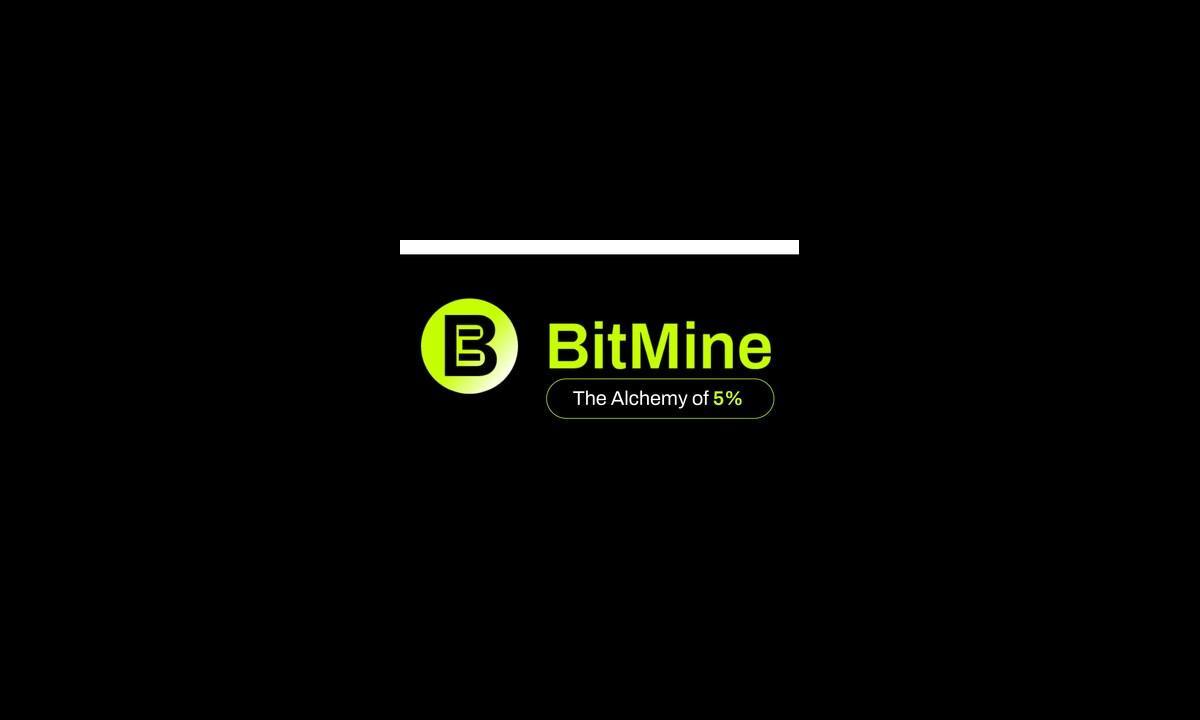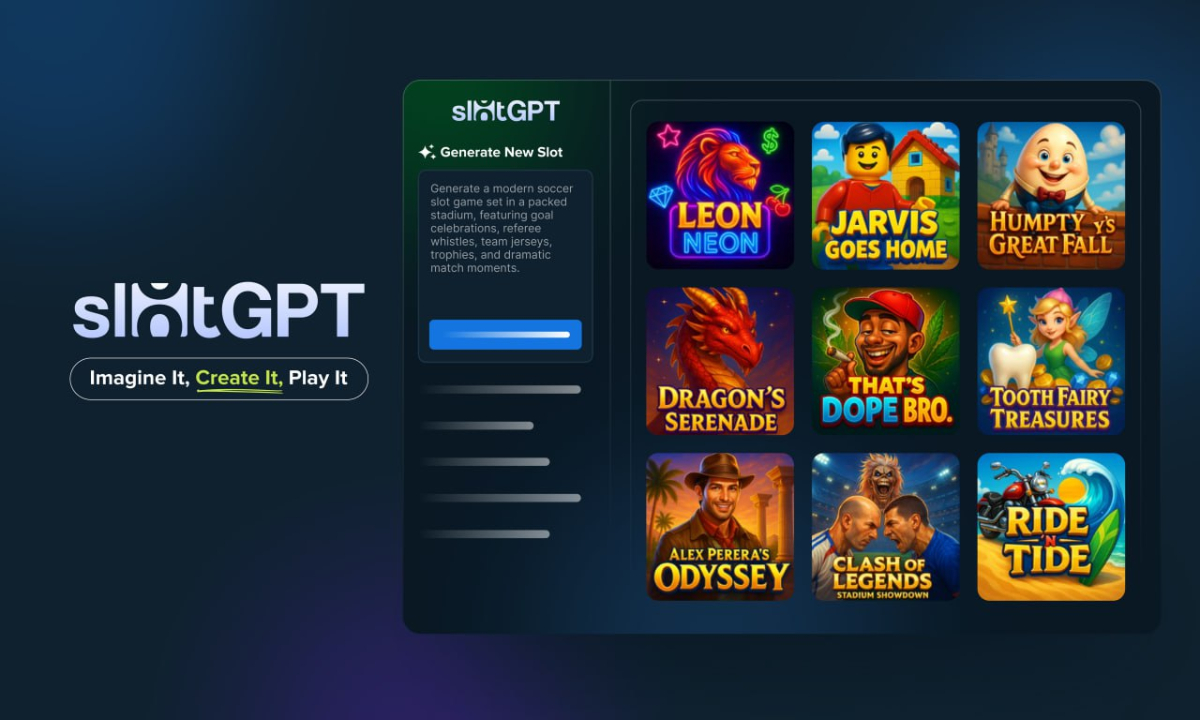ether.fi Review: What Makes The 49th Listing Project On Binance Launchpool Unique?
ether.fi Review, the latest substantial project in the Liquid Restaking field, now holds the highest Total Value Locked (TVL) in this sector, drawing over $32M from notable funds. Significantly, it’s the first project in the “Restaking” category to be listed on Binance, ranking 49th on Binance Launchpool.
What Is ether.fi?
ether.fi is a prominent protocol in the Liquid Restaking field. It provides stakers and Node operators a platform to participate and earn profits. This arrangement allows Node operators to join without needing a total 32 ETH, as the stake comes from stakers.

Originally, ether.fi was a Liquid Staking project that supported ETH staking and Node operation on the Ethereum chain. However, given the robust growth of Restaking, the project shifted its focus to support liquidity staking on EigenLayer.
Direct staking on EigenLayer would lock up liquidity and impose a 7-day waiting period for asset withdrawal. As such, ether.fi serves as an intermediary, receiving assets from users and transferring them to EigenLayer on their behalf. Importantly, when sending ETH or LST to ether.fi, you also receive LRT eETH, which can be used as collateral or sold at any time.
As a result, when you stake assets on ether.fi, you receive a staking Reward on Ethereum (APR 4%), a Restaking Reward on EigenLayer (Eigen Points), and ether.fi Points.
The project distributes all staking rewards received in the ratio of 90%, 5%, and 5% to stakers, Node operators, and the protocol, respectively.
Main Feature of ether.fi
In addition to some basic features, ether.fi offers:
- Staking: This allows users to stake ETH and liquid staking tokens (LST) to receive an equivalent amount of eETH in return (i.e., 1 ETH = 1 eETH).
- DeFi: A collection of protocols and platforms allowing users to use eETH and wETH for DeFi activities such as staking, providing liquidity, borrowing, voting to receive commissions (bribe), etc.
- Solo Staker: This enables participating users to register as Ethereum node operators without risking ETH.
- Institutional Staking: This feature allows organizations to join ether.fi’s ETH Fund and stake large amounts of ETH, delegating node operations to platform partners.
- NFT Platform: Users can stake ETH to mint Fan NFTs and receive additional APR for different durations, including 60, 90, and 120 days. The amount of ETH staked also gets transferred to the solo staker program on ether.fi.
Products Of ether.fi
Staking
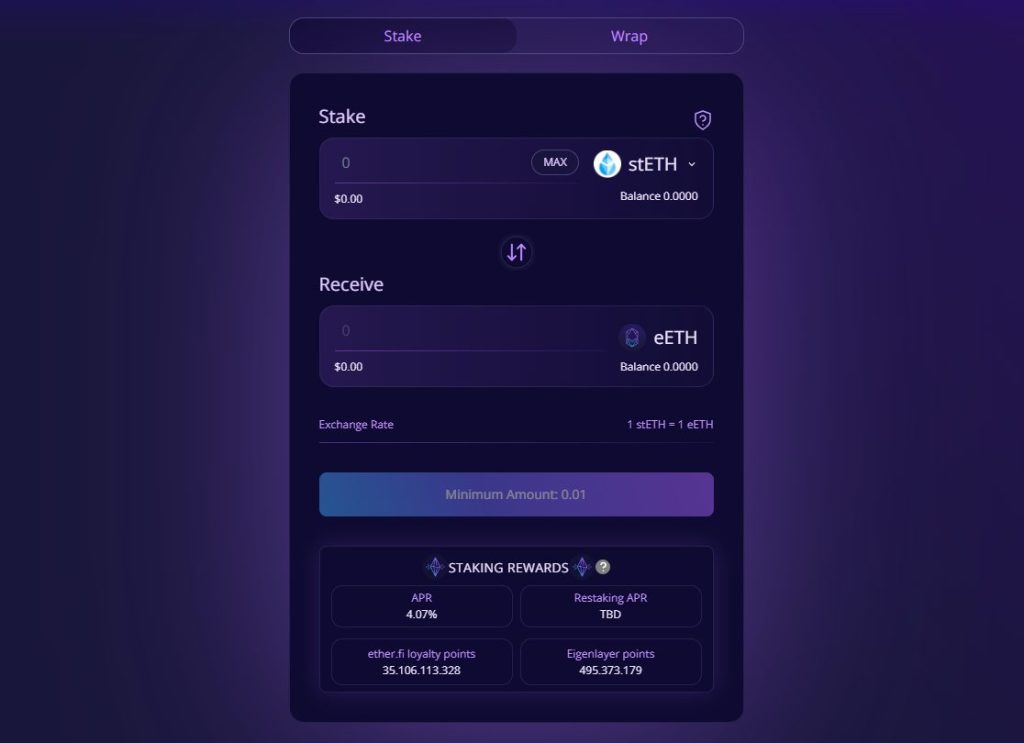
The ether.fi protocol enables users to stake ETH and liquid staking tokens (LST) in exchange for an equivalent amount of eETH (i.e., 1 ETH = 1 eETH). As previously mentioned, ether.fi utilizes the staked tokens to participate in Native Restaking on the EigenLayer platform. Thus, users participate in ether.fi will benefit from cumulative profits from various sources, including:
- APR from token staking currently at 4.66%
- APR from retaking tokens, which allows for the division of restaking profits on EigenLayer between ether.fi and its users
- Bonus points from EigenLayer. All points ether.fi earns from retaking tokens on EigenLayer and returns them to users based on the assets they have staked. This ensures that users also receive the full benefits associated with EigenLayer points
- Reward points from ether.fi, also known as loyalty points. For every 0.001 ETH staked, users receive 1 point/day. These points will be used in the project’s decentralized governance mechanism in the future. The formula for calculating ether.fi points are as follows: (number of ETH staked) * (1,000) * (number of days staked)
After receiving eETH, users also have the option to convert it into weETH. Compared to eETH, this wrapped version will likely be supported by many DeFi protocols and offer additional utilities such as borrowing, lending, and trading.
DeFi
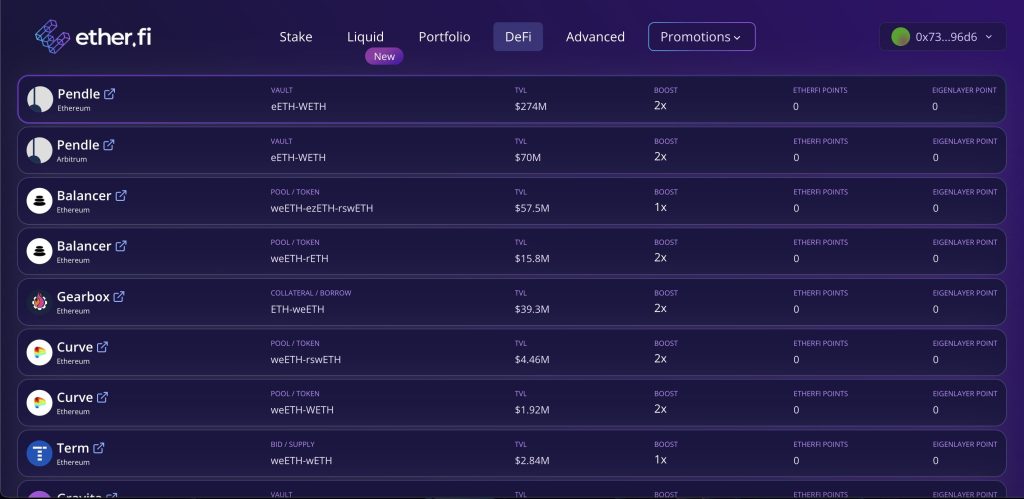
DeFi features comprise a collection of protocols and platforms, allowing users to utilize eETH and wETH for various DeFi activities. These activities include staking, providing liquidity, borrowing, and voting to earn commissions.
Using eETH and wETH on different platforms can also increase a user’s ether.fi points. The boost level varies depending on the protocol, with examples such as 1x, 2x, 6x, etc.
In this manner, users not only earn staking rewards on ether.fi, but they can also maximize their profits based on rewards from other platforms. These include prominent names like Pendle, Balancer, Curve, Gearbox, Gravita, and more.
Solo Staker
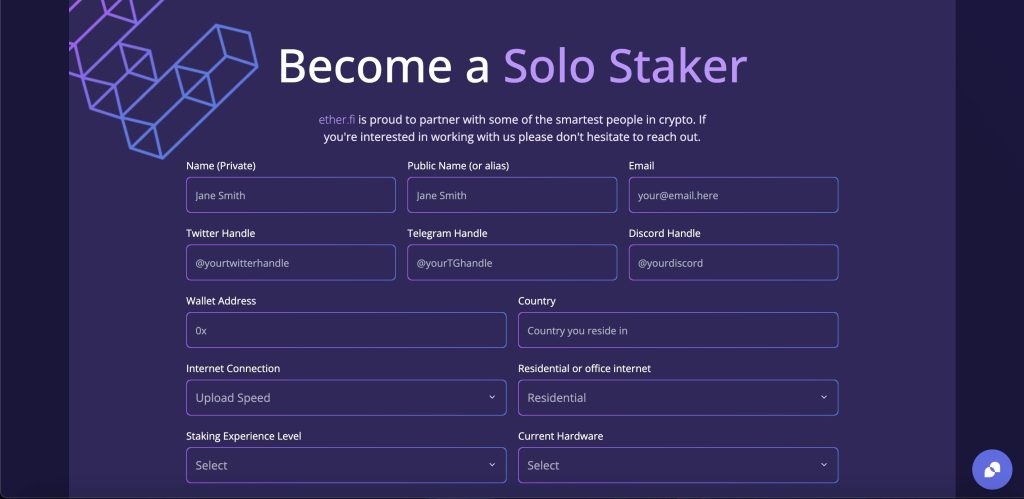
Solo Staker enables users to register as Ethereum node operators without needing to stake ETH. This feature results from a collaboration between ether.fi and its subscribers.
In this collaboration, ether.fi offers ETH from its platform’s stakers and provides extra software and technical support. As a result, ether.fi can operate a validator node on Ethereum and use DVT* technology to ensure system decentralization.
Users need available hardware and an internet connection. By registering as members of ether.fi’s DVT system, they can validate transactions on the Ethereum network and receive rewards.
- DVT (Distributed Validator Technology) allows multiple parties to operate a validator node. It does this by breaking the validator’s private key into many pieces and distributing them among multiple parties for joint transaction authentication and management.
To inaugurate the Solo Staker program, ether.fi has partnered with three staking infrastructure projects: Obol Network, Avado, and Dappnode.
Institutional Staking
Institutional Staking is a feature that enables organizations to participate in ether.fi’s ETH Fund. This feature allows them to stake large amounts of ETH and delegate node operations to platform partners such as Finoa, dappnodes, DSRV, Chainnodes, Obol, NodeRun, Cosmostation, and A41.
The project guarantees the safe and secure storage of tokens that organizations deposit in the ETH Fund, managed by Finoa, a European crypto asset management company. Furthermore, the fund undergoes annual KYC and audits, and ether.fi provides monthly reports on the fund’s status to maintain transparency.
ether.fan NFT Staking

ether.fan is an innovative platform designed for users who wish to stake their ETH to mint unique Fan NFTs. This process not only allows users to generate these digital assets but also comes with the added benefit of earning extra Annual Percentage Rate (APR) rewards. These rewards are applicable for various durations, offering users flexibility. The durations include shorter terms like 60 days, mid-range like 90 days, and longer durations like 120 days.
As an added advantage, ether.fan also includes transferring the amount of ETH staked by users to the solo staker program on the ether.fan platform. This feature provides another layer of potential returns for users, optimizing the utilization of their staked ETH. This synergy between ether.fan and ether.fi amplifies user benefits, making it a comprehensive solution for staking and minting activities.
Read More: Best Bitcoin Mining Hardwares In 2024 (Expert Reviewed)
Tokenomics and Use Case
Token Allocation
Token Name: ETHFI
Token Type: ERC-20
Initial Supply: 115,200,000 (11.52% of the total supply)
Total Supply: 1,000,000

- Binance Launchpool – 2%: This portion is allocated for the Launchpool program on Binance.
- Airdrop – 11%: This rewards those who contribute to the project’s success.
- Investors & Advisors – 32.5%: This is set aside for investors and advisors.
- Team – 23.26%: This is dedicated to the team as a reward and motivation for them to continue contributing to the project.
- Protocol Guild – 1%: These are rewards for parties participating in the project’s Guild.
- DAO Treasury – 27.24%: This serves as a reserve fund aimed at mitigating risks and supporting project development strategies.
- Liquidity – 3%: This is allocated for creating initial liquidity for the project’s Token
Token Use Case
ETHFI is the native governance and utility token for the ether.fi protocol. It is utilized in the following scenarios:
- Management and upgrades of the protocol
- Revenue sharing for token holders
Vesting Schedule
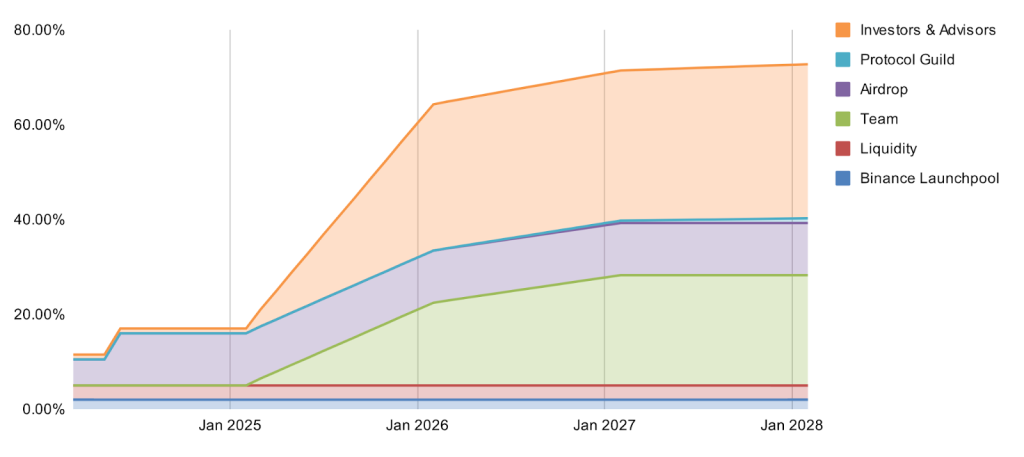
Approximately half of the initial supply is distributed to the community through Launchpool and Airdrop. The creators, investors, and advisors hold the remaining supply.
Team and Investors
Team
- Mike Silagadze – CEO: Mike has experience as the CEO of Gadze Finance and is the founder of Top Hat.

- Rok Kopp – Chief Growth Officer: Rok has extensive management experience, having served as the director of several companies, including Groupon, Top Hat, Apto, and Obsidian HR.

- Joseph Vogel – COO: Joseph holds a Bachelor’s degree in Accounting and has worked for BDO, MUFG Investor Services, TAAL Distributed Information Technologies, and Aave.

Investors
- 02/2023: Raised $5.3 million in a funding round valued at $53 million from various investors, including Arrington XRP Capital, Chapter One, Node Capital, Maelstrom, Version One, and others.
- 02/28/2024: Secured $27 million in a Series A round with a valuation of $270 million from several investors, including ConsenSys, CoinFund, Arrington XRP Capital, OKX Ventures, Sandeep Nailwal, and more.
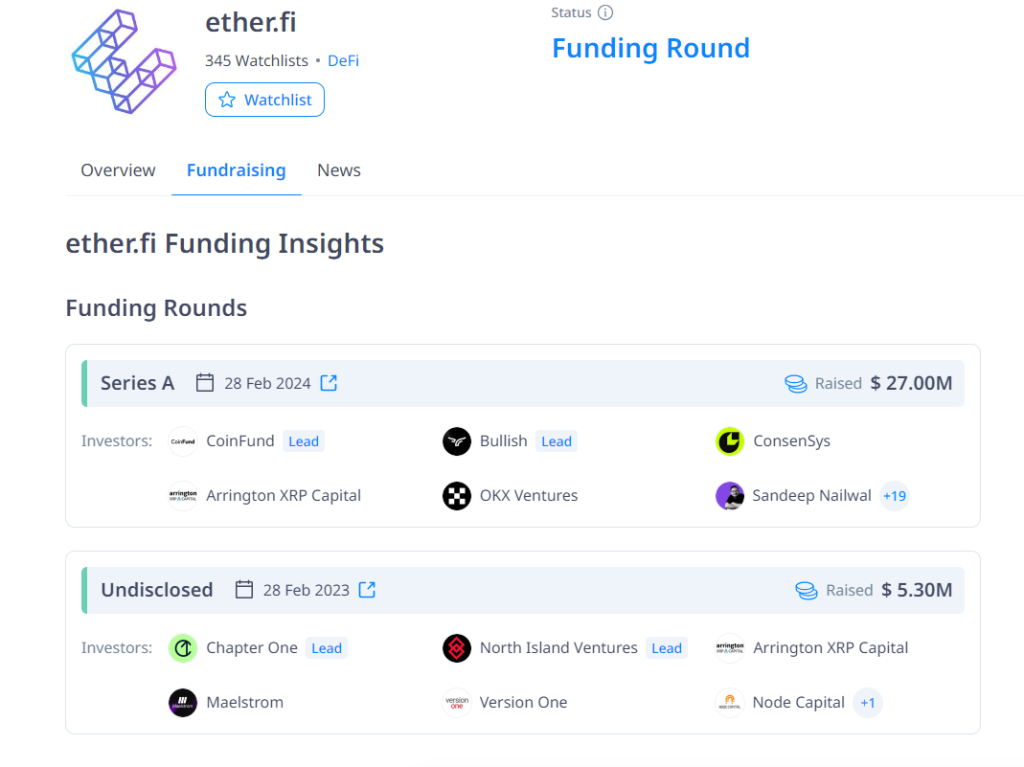
Read More: Top 10 Best Solana DEX Ranking in 2024
Future Developments and Roadmap
- Delegated staking with self-custody of keys (Completed – June 2023): ether.fi’s decentralized application provides a secure path to staking personal ETH in 32 validator increments with a set of secure and proven node operators.
- Solo node operators integration phase 1 (Completed – August 2023): ether.fi, in conjunction with Obol Labs, spun up the first DVT mainnet validator and leveraged this into the mainnet’s first cohort of validators run by a geographically dispersed group of small, independent operators.
- DVT integration phase 1 (Completed – August 2023): The above proof of concept has been partially automated with eyes on full automation in Phase 2 below.
- Open-source smart contracts (Completed – October 2023): As a further commitment to our belief in the Ethereum ecosystem, we’ve officially open-sourced our suite of smart contracts. We believe this will improve our protocol’s trust, quality, reliability, and security.
- eETH launches with permissionless minting and redemptions (Completed – November 2023): eETH is ether.fi’s Liquid Staking Token, which will launch within a month. With it, users can participate in Ethereum staking in a fully permissionless manner, buying and selling staked assets on demand.
- Open source everything (ETA Feb 2024): As a further demonstration of our belief in the power of free and open, we’ll continue making our software services and code public. We hope to drive others in the ecosystem to do the same.
- DVT integration phase 2, permissionless solo staking (ETA April 2024): In DVT Phase 1, working with our partners at Obol Labs, we delivered secure mainnet DVT—validation shared by disparate individuals, none of whom held entire validator keys. This second phase will move toward a fully automated integration. Users will arrive, apply, and begin acting as solo stakers, free and clear of ether.fi and Obol’s management and assistance.
- DAO Governance & TGE (ETA April 2024): One of the primary goals for ether.fi from the start has been for the protocol to outlive us (it’s primary developers). With a collective governance model, we believe we’ll leave the protocol open and in the capable hands of the vested many.
- Contracts ossification (TBD): The natural process of software stability takes time and iteration. ether.fi is committed to removing upgradability from our smart contracts, but this process must first run its course.
Read More: Top 10 Best GameFi Projects In 2024
How to Stake ETH on ether.fi: A Comprehensive Guide
Step 1: Visit this link
Step 2: Click on “Stake Now”

Step 3: Select “Connect Wallet” to connect your wallet
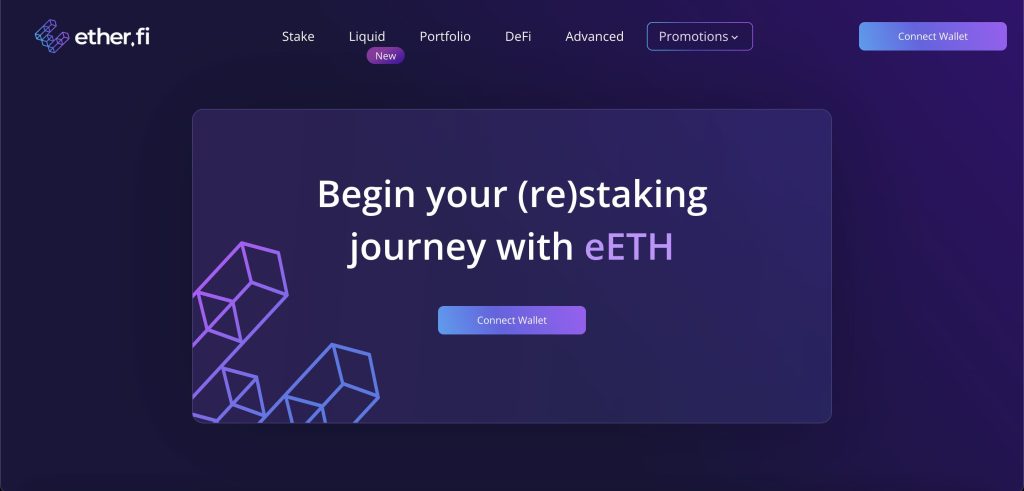
Step 4: Choose the type of token you want to stake. ether.fi supports ETH and six types of LSTs, including stETH, RSstETH, cbETH, RScbETH, wBETH, and RSwBETH.
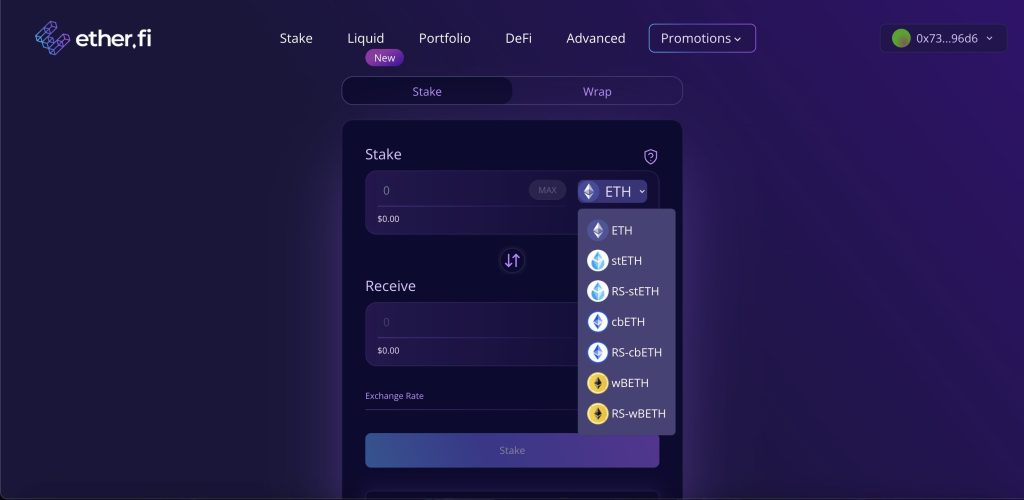
Step 5: Enter the number of tokens
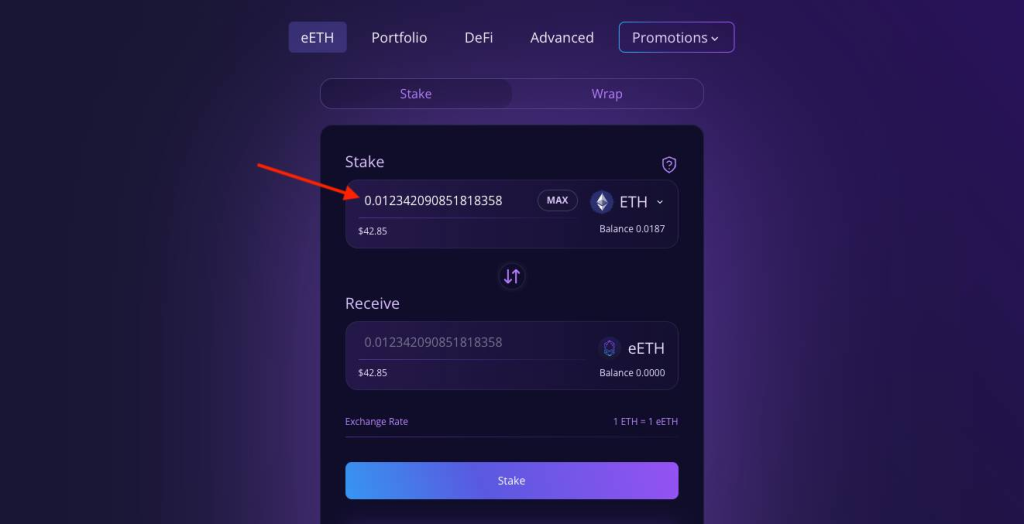
Step 6: Select “Stake” -> Confirm the transaction to complete. After the transaction is completed, users will receive eETH in their wallet.
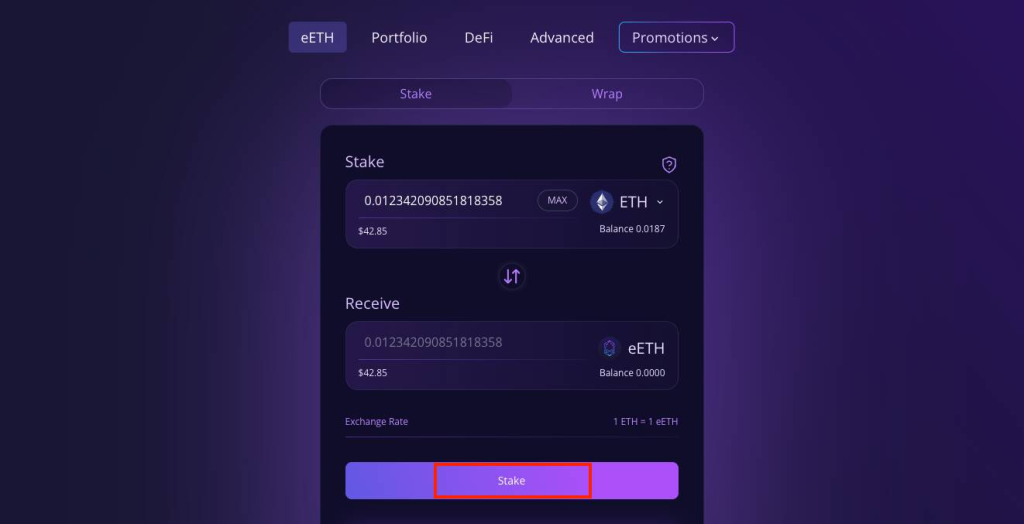
When participating in staking on ether.fi, users will have the opportunity to earn EigenLayer Points and ether.fi Loyalty Points, which can be used for future airdrops to users.
Conclusion
In this ether.fi review, ether.fi is a leading project in liquid restaking, a sector with immense potential, both now and in the future. Although it currently leads, competing projects such as KelpDAO, Renzo, and Puffer are not far behind. It remains to be seen whether ether.fi can sustain its current position utilizing its advantages.
CoinCu rates this as the top project in the restaking sector, with tremendous potential that could lead the entire market. This is particularly true as EigenLayer has already surpassed the $6 billion TVL milestone. Sub-projects will likely benefit significantly, especially users who will receive airdrops from the project and EigenLayer.
| DISCLAIMER: The information on this website is provided as general market commentary and does not constitute investment advice. We encourage you to do your own research before investing. |













